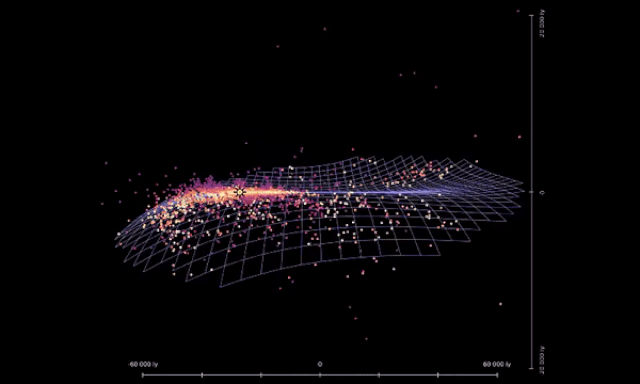Astronomers have found that the Milky Way Galaxy is “warped and twisted” just like its inhabitants

Surprisingly, at least to me, is this shit! The Milky Way Galaxy ain’t flat like a pancake. Instead, our galaxy’s stellar disk is an s-shape. Pretty fucking wild.
Gizmodo:
A team of Polish astronomers has created the most accurate three-dimensional map of the Milky Way to date, revealing surprising distortions and irregularities along the galactic disk.
Building an accurate map of the Milky Way is not easy.
Our location deep inside the gigantic structure means we can’t observe our galaxy externally, forcing us to envision its form from within. Dense expanses of stars, gas, and dust complicate our view even further. Despite these limitations, we know that the Milky Way is a spiral galaxy measuring around 120,000 light-years across, and that we’re located around 27,000 light-years from the galactic core.
Over the years, astronomers have employed various attempts to map our galaxy, including star counts, radio observations of gas molecules, and even extrapolations of similar spiral galaxies nearby. These efforts have resulted in maps that are decent but not great. A better way to map the Milky Way would be to directly measure our distance to a large sample of stars strewn across the galactic disk. Better yet, the stars used in this sample would belong to a specific, well-studied type to ensure observational accuracy.
Using this strategy, a team of scientists from the Astronomical Observatory at the University of Warsaw has compiled the most accurate 3D map of the Milky Way to date. Astronomer Dorota Skowron led the study, which was published today in Science.
Among several other new findings, the updated 3D map shows the S-shaped structure of our galaxy’s distorted stellar disk. The Milky Way is not flat like a pancake, and is instead “warped and twisted,” in the words of co-author Przemek Mroz, who described his team’s work in a related video. That our galaxy is warped was already known, but the new research further characterizes the surprising extent of these distortions. As the new research shows, this warp starts at ranges greater than 25,000 light-years from the galactic core, and it gets more severe with distance.
“If we could see our galaxy from the side, we would clearly see its warp,” Skowron told Gizmodo. “Stars that are 60,000 light-years away from the Milky Way’s center are as far as 5,000 light-years above or below the Galactic plane,” she said. “This is a big percentage.”
In terms of a cause, the researchers attributed interactions with neighboring galaxies, intergalactic gas, and possibly even dark matter.
The new research also showed that the thickness of the Milky Way is variable throughout. Our galaxy gets thicker with distance from the core. At our location, for example, the galactic disk is about 500 light-years thick, but at the outer edges it’s as much as 3,000 light-years thick.
To create the 3D map, Skowron and her colleagues charted the location of Cepheid variable stars. These young, pulsating supergiants are ideal for this research because their brightness changes in a very regular pattern. Ultimately, the location of Cepheid stars within the Milky Way can be more accurately pinned down than other kinds of stars, which is precisely what was needed for this mapping project.
A sample of over 2,400 Cepheids was used to create the new map, the majority of which were identified with the Optical Gravitational Lensing Experiment (OGLE) survey, which monitors the brightness of nearly 2 billion stars. In total, the researchers observed the galactic disk for six years, taking 206,726 images of the sky.
The 1.3-meter (4.3-foot) Warsaw telescope in the Chilean Andes is used for the OGLE survey, and it can monitor the brightness of stars and measure their properties for years. This makes the map more spatially complete than maps produced by data from the Gaia satellite, for example, in which distances are reliable only to 10,000 to 15,000 light-years, said Skowron. Also, the new map is more accurate than previous efforts because of the greater number of stars and the “very high purity” of the Cepheids samples, she said.
“So this is the most ‘real’ map of the Milky Way,” Skowron told Gizmodo.
If this work sounds familiar, it’s because research published earlier this year in Nature Astronomy employed a similar technique, in which scientists from the Chinese Academy of Sciences reached similar conclusions, using a different group of Cepheids for their map. One of the scientists behind the previous research, Xiaodian Chen from the National Astronomical Observatories at the Chinese Academy of Sciences, took issue with the fact that the authors of the new paper did not cite his team’s work. Nonetheless, he still liked the new science.



